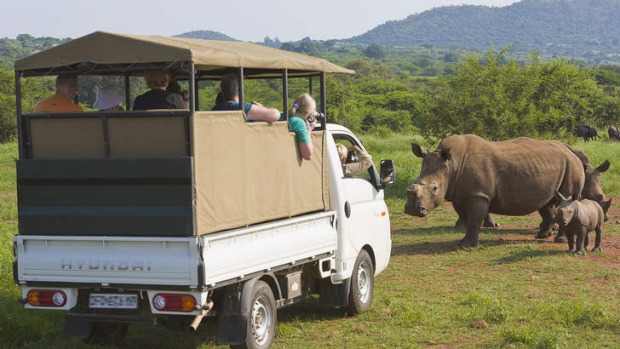
Before Indiana Jones, there was Allan Quartermain. When I was a kid I loved the hero of King Solomon's Mines, who never flinched at snakes or cracked a whip like a mere circus performer. Quartermain toted an 8-bore rifle, stared down elephants and lived in a world of Zulu warriors and leopards.
Unfortunately, I'm only five minutes into my South African walking safari when I realise I'll never live up to my hero. My heart is hammering in my chest and I twitch at every rustling leaf.
The guard who accompanies me brings little reassurance. His shotgun is certainly not at the ready, and he's too skinny to interest a lion. I, on the other hand, am overweight and well-flavoured by the lamb and red wine I had for lunch. I'd be a choice morsel for the lions I know are out there. Only that dawn, from the safety of a safari jeep, I saw one limbering up in a thicket as if contemplating a day's hunting.
My tracker Philip grins at my fears. "Why worry about lions? Giraffes have a kung-fu kick that can take your head off," he chortles. "Besides, we're tracking rhino: 3000 kilos of raw power, topped by a 90-centimetre horn that can punch a hole through a mere lion."
OK, so a walking safari through Phinda Private Game Reserve seemed a good idea at the time. I was a bit over trundling around in the back of a jeep with retired American dentists. Why not have my Allan Quartermain moment instead?
And true, following a rhino on foot is an exhilarating wildlife experience - but utterly unnerving too. The bush here is nothing like the open savannah of East Africa, but made up of dense grass and thorny trees interrupted by small hills. "You could practically step on a rhino before you see it," as Philip cautions happily. Meanwhile, he distracts me by pointing out the smaller creatures and plants often missed on drive safaris.
We admire golden orb spiders with yellow-and-black backs, green-blue starlings, and the pink trumpet-like flowers of the devil's thorn as giraffe necks swivel on the horizon.
Soon there's evidence of passing rhinos. Philip points out fresh scuff marks on tree trunks and footprints shaped like giant shamrocks. When we come to a pile of dung he thrusts a finger into it. "Still warm; they're about 20 minutes off. See the twigs? That's black rhino dung. White rhinos only eat grass."
When we come upon dung still steaming, my adrenalin levels kick up another notch. We tiptoe along, trying not to crunch leaves: rhino have poor eyesight but excellent hearing, and are easily spooked.
And then, there they are, just 10 metres away. Three rare black rhinos each about the size of a hatchback, ripping acacia thorns off bushes as if enjoying popcorn. I can hear their chewing. They have a musky smell and an impressive presence. Being steps away from animals in the wild is always a visceral experience, but this is sheer awe combined with terror. Every instinct suggests rash danger, but human curiosity has me spellbound.
Then the rhinos are gone, vanishing into the landscape like a magic trick. I feel a sudden urge for a gin and tonic, but first I have to get back to my lodge alive.